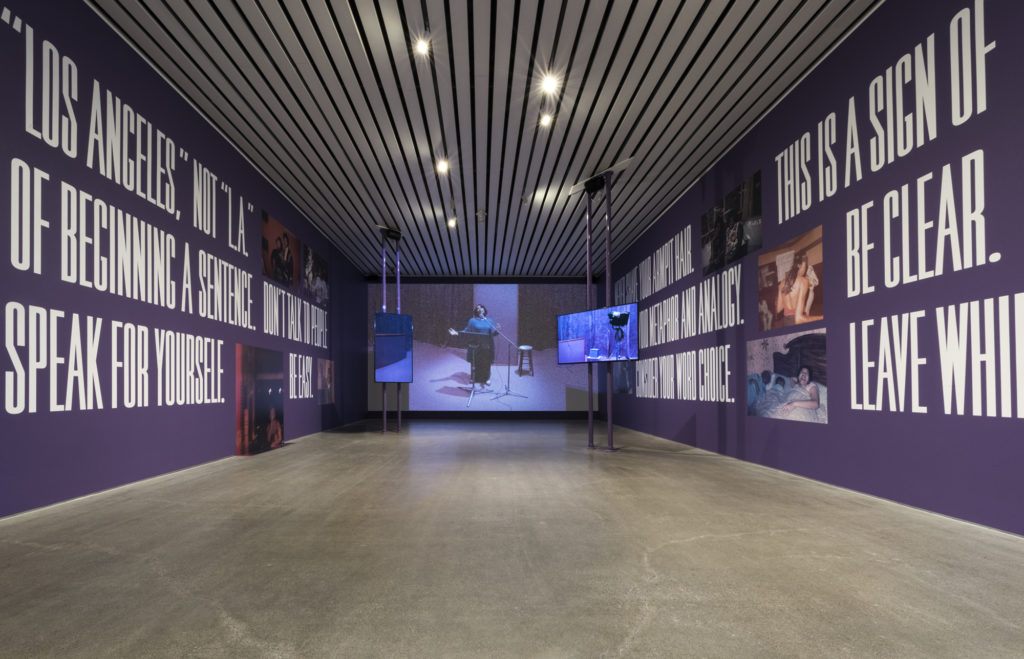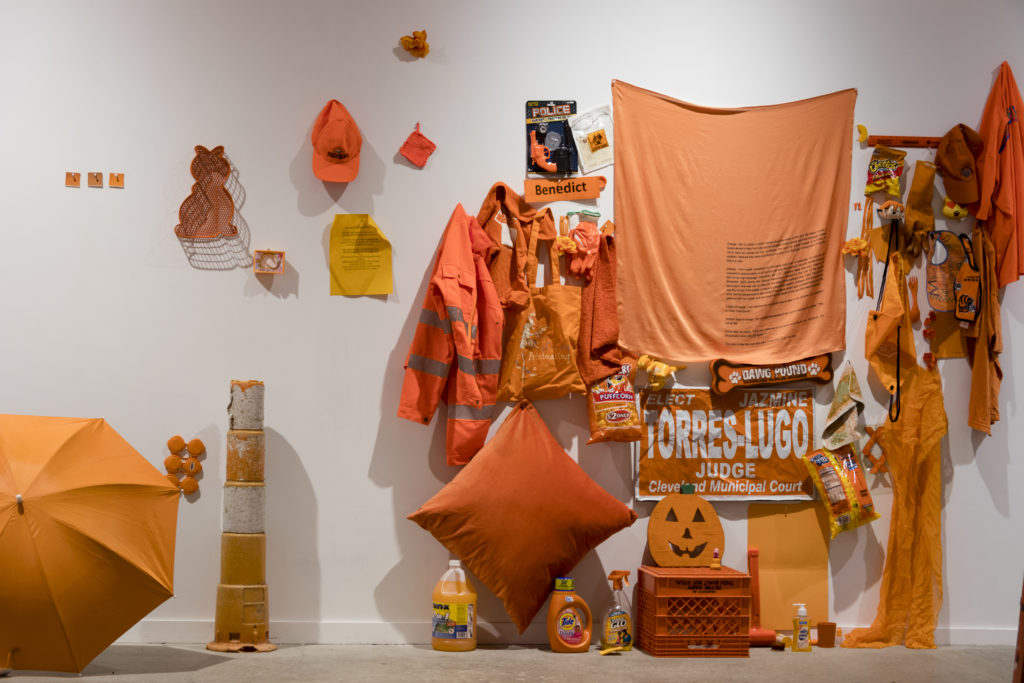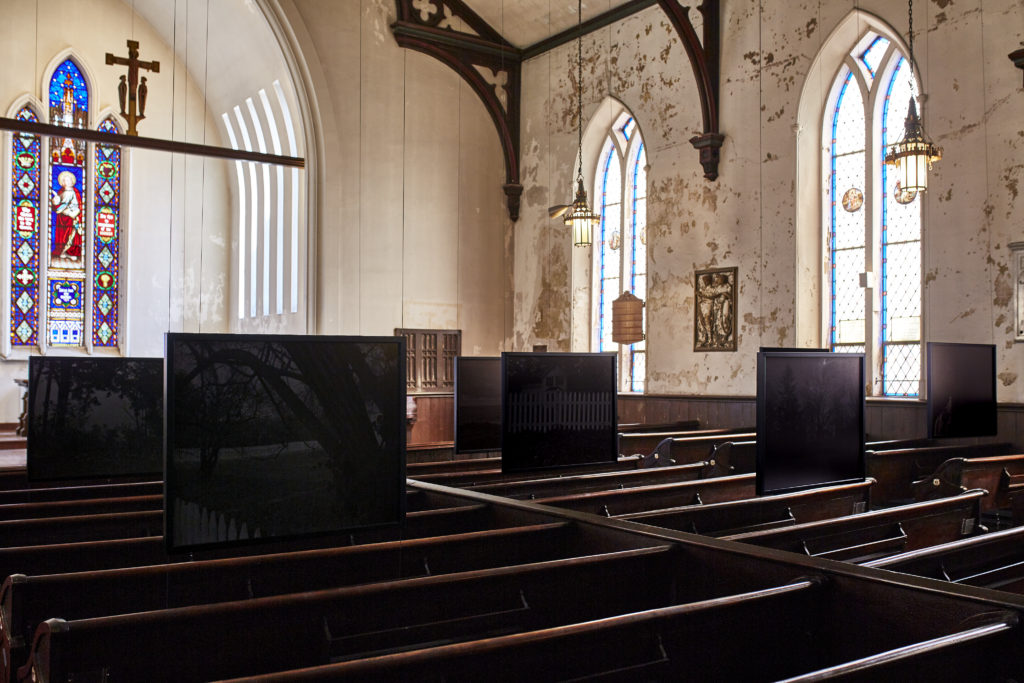From the Front: Front International
by Susan Snodgrass

Urban activist and author Jane Jacobs saw cities as “immense laboratories” for invention. “[L]ively, diverse, intense cities contain the seeds of their own regeneration,” she argued, “with energy enough to carry over for problems and needs outside themselves.”1 An American City, the inaugural edition of FRONT International: Cleveland Triennial for Contemporary Art, is an experiment in urban development: a cultural laboratory that hopes to reshape the image of this post-industrial city by positioning itself as a “heartland documenta.”
This is, at least, the vision and claim of FRONT Executive Director Fred Bidwell, who appointed Michelle Grabner as Artistic Director to curate its first iteration.2 Enlisting over 100 artists, whose works occupy almost thirty sites (including venues in Oberlin and Akron, Ohio), Cleveland is the nexus and often subject for the exploration of ideas both political and artistic—racism, violence, immigration, the role of art in healing and building community—that simultaneously frame and transcend its spatial conditions. Thus, what unfolds is a remapping of the city; the coordinates of which include museums and cultural institutions, civic and community spaces, historic sites, Victorian-era arcades, and a city market, best accessed by charting one’s own course. Adopting a kind of Situationist dérive, by which according to Guy Debord the “psychogeographical contours” of the city are revealed through wandering or drifting, helps build a portrait of Cleveland that counters mere cultural tourism.
As the fifth largest city in the United States at the turn of the last century, Cleveland once prospered as one of the nation’s central transportation and manufacturing hubs. But like many midwestern cities, its economy faltered during the mass deindustrialization that swept the country during the late 1970s, a position from which it is, in many ways, still recovering. Today, Cleveland wears of a mix of beauty and brawn as evinced in the photographic installation Then and Now (2018) by Allen Ruppersberg, a Cleveland native, at the Cleveland Museum of Art (CMA). Street scenes and sweeping vistas of the city’s skyline taken from the vantage point of various billboards are illuminated in a series of LED light boxes, each framed by a photomural of the billboard’s steel support. Across the work’s eight scenes, one views remnants of Cleveland’s industrial past in tandem with signs of growth and new development, together offering a panoramic view of a city in transition.
Investigations of Cleveland’s architectural history inform commissioned projects by Marlon de Azambuja and Luisa Lambri, also at the CMA, that mine the physical spaces of the museum itself. In a continuation of his series of sculptural installations exploring the legacies of brutalist architecture, Azambuja has amassed bricks, cement blocks, slabs of stone, and concrete culled from throughout the city into vertical configurations that form their own cityscape, its muscularity oddly elegant within the museum’s glass box gallery. At once a material homage to brutalist architecture in the Northeast Ohio region, Brutalismo-Cleveland (2018) also references architect Marcel Breuer’s 1971 addition to the CMA’s original building. Defined by its façade of two-toned stripes of gray granite, Breuer’s “banded brutalism” is additionally the subject of Lambri’s adjacent untitled photographs that render the museum’s architectural details as intimate studies in abstraction.
Lambri, whose photographs deconstruct iconic buildings and male architectural histories with a poetic subjectivity, is one of a few female artists, in addition to Martine Syms and Candice Breitz, given either a significant institutional showing or large-scale commission within Cleveland. (Both Barbara Bloom and Cui Jie have solo exhibitions in Oberlin.) Syms’ An Evening with Queen White (2017), at the Museum of Contemporary Art (MOCA) Cleavland, performs constructions of black female identity in this four-channel video work presented across three monitors and a projection screen. The central protagonist, Queen White, is an invented character based on Syms’ great aunt Maxine Powell, an etiquette instructor at Motown Records, personified by actress Fay Victor in an improvisational monologue. In the related 99 Subtle Maneuvers (2018), enlarged photographs of the artist’s family are scattered amid declaratives such as “Always speak for yourself,” “Be clear,” and “Never shave your armpit hair,” emblazoned in large white letters upon Motown-purple walls.
Breitz’s Love Story (2016) is a powerful seven-channel video installation on view at Playhouse Square theater. Love Story explores the global refugee crisis from the perspective of six actual individuals whose stories of oppression and search for asylum are performed by actors Julianne Moore and Alec Baldwin in dramatized montages, that are projected obverse to the original interviews exhibited in a second gallery. As one of about six site-specific projects situated within the city’s downtown, Love Story solicits viewers to consider how the media constructs public understanding of asylum seekers. The work creates a resonant dialogue with The American Library (2018), a timely installation on immigration and national identity by Yinka Shonibare MBE at the nearby Cleveland Public Library. Adapting a previous version of the work, Shonibare worked with local librarians to identify names of immigrants to the US who have made important contributions to American arts and sciences—as well as those who openly oppose immigration, or whose ideas inform current debates. Their names appear stamped in gold on the spines of some 6,000 tomes cloaked in the artist’s signature Dutch wax batik cloth and arranged on a large horizontal bookshelf, commanding in content and scale. The American Library opens the narrative of immigration to speak to the plurality of cultural identities that define American cities, extended through an online component of the work that includes a searchable database to access the gathered biographies and allows viewers to contribute their personal histories of migration.

While wonderfully suited to their individual sites—as were other installations, including Allan Sekula’s maritime-themed film Lottery of the Sea (2006) shown aboard a retired steamship—such works have garnered considerable attention elsewhere on the global art circuit. What they bring to FRONT, and Cleveland, aside from international visibility is the opportunity for understanding broader cultural conflicts in a city and region that have played a crucial role in contemporary American electoral politics.3 But just as Jacobs saw neighborhoods as the lifeblood of cities, the real strength of FRONT exists through the projects that are sited in alternative spaces and neighborhood venues, making visible local histories and social issues of importance to both their respective communities and beyond. These embedded practices succeed in their deep commitment to place.
The emotional traumas of police violence on black lives are the focus of A Color Removed (2018), an ambitious, multilayered exhibition and collaborative project led by Michael Rakowitz at SPACES gallery in the Ohio City neighborhood. Created in response to the 2014 murder of 12-year-old Tamir Rice, fatally shot by a police officer in a public park in Cleveland, inciting public protests nationally, the project advocates for social justice and the right to safety. The title refers to the orange safety cap missing from Rice’s toy gun, which was mistaken for a real firearm at the time of the shooting; it is also a call to action for the removal of all orange-colored objects from the city, collected by the public and placed in depositories throughout Cleveland. The gathered items—including household products, safety vests, construction tools and traffic pylons—form the artefactual basis for a gallery-wide installation that renders the objects’ utilitarian functions useless. A Color Removed includes related works by several Cleveland-based artists and is simultaneously conceived of as a community space for public discussions, dinners, and other events, many co-organized with the Rice family.
Dawoud Bey’s photographic installation Night Coming Tenderly, Black (2017) at nearby St. John’s Episcopal Church is a moving tribute to Cleveland’s fundamental role in the Underground Railroad. Installed among the pews of this historic church that served as a key stop along the line to freedom, Bey’s shadowy images (fourteen in total) imagine the passage of fugitive slaves moving through the darkness of night, from Hudson, OH, to Cleveland, then across Lake Erie. Like the closing refrain of the Langston Hughes’ poem from which the project takes its name, Bey’s constructed landscapes celebrate blackness while giving material evidence to this significant narrative in African-American history.4
The church as a vital center of contemporary black life is explored in Johnny Coleman’s two-part Reflections from Here: Elders of Glenville (2018), the result of an oral history project that evolved over the course of several months in which this Oberlin-based artist interviewed elders from the Glenville neighborhood. Their hopes and memories form the basis for an audio installation at St. Mark’s Church, an important fixture in this predominately black community until its recent closure. A platform installed outside the entrance supports two rows of pews, a pulpit, and a pair of handcrafted African grandfather chairs, creating a contemplative space for honoring and listening. The second part, at MOCA, is sited in front of a window facing Glenville—here, two chairs sit with a telescope, its lens replaced by an iPod with an image of the church’s façade.

Coleman’s project, one of the few commissioned pieces by an Ohio-based artist, bridges the institutional spaces of MOCA and communities like Glenville, at the same time it symbolizes the kind of self-reflexivity that projects like FRONT offer and pledge. As one of a new crop of regional art biennials focused on the Midwest—including Open Spaces in Kansas City—FRONT suggests a growing need to align smaller cities and communities within cultural dialogues happening elsewhere, and yet remain responsive to local interests and context. Such strategies belong to a critical regionalism that is neither provincial nor parochial, but very much engaged with a broad set of social and political dynamics that simultaneously inform the local and the global. These dynamics could have been pushed further with more visibility given to regional artists outside the Great Lakes Research project, a group exhibition of twenty-one artists from the greater Midwest at the Cleveland Institute of Art. However, FRONT succeeds first and foremost by offering an experiential encounter with Cleveland. Rather than emulating documenta—particularly given the issues that plagued the last edition where the economic conditions of the Athens site clashed with the artworld festivalization—FRONT has the ability to establish its own model. Best practices bring cultural capital and creative resources to artists from the region, as well as new models of civic engagement that serve local citizens long after the first wave of visitors have left town.
FRONT International: Cleveland Triennial for Contemporary Art runs from July 14–September 30, 2018.
- Jane Jacobs, The Death and Life of Great American Cities (NY: Vintage Books, 1992 edition), p. 448.
- Jens Hoffman initially served as Co-Artistic Director but departed abruptly in November 2017 ahead of his termination from the Jewish Museum and the Museum of Contemporary Art Detroit amid sexual harassment allegations.
- Ohio voted Republican in the last election; Cleveland, the seat of Cuyahoga County, voted blue.
- For an expanded discussion of the artist’s project, see “Dawoud Bey: Visualizing Memory,” THE SEEN, Issue 06, 2018, pp. 88–99.